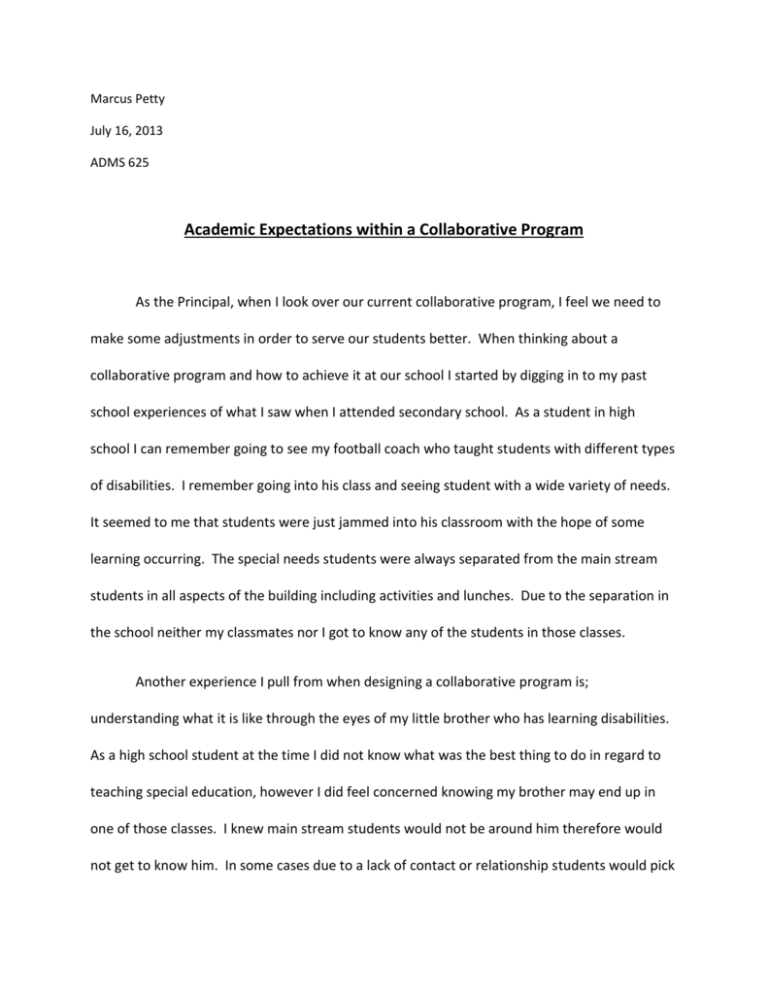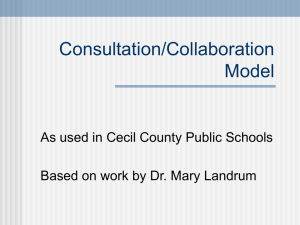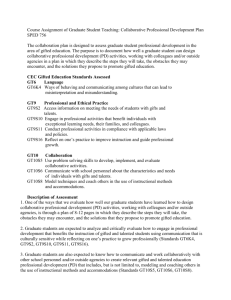Academic Expectations within a Collaborative Program
advertisement

Marcus Petty July 16, 2013 ADMS 625 Academic Expectations within a Collaborative Program As the Principal, when I look over our current collaborative program, I feel we need to make some adjustments in order to serve our students better. When thinking about a collaborative program and how to achieve it at our school I started by digging in to my past school experiences of what I saw when I attended secondary school. As a student in high school I can remember going to see my football coach who taught students with different types of disabilities. I remember going into his class and seeing student with a wide variety of needs. It seemed to me that students were just jammed into his classroom with the hope of some learning occurring. The special needs students were always separated from the main stream students in all aspects of the building including activities and lunches. Due to the separation in the school neither my classmates nor I got to know any of the students in those classes. Another experience I pull from when designing a collaborative program is; understanding what it is like through the eyes of my little brother who has learning disabilities. As a high school student at the time I did not know what was the best thing to do in regard to teaching special education, however I did feel concerned knowing my brother may end up in one of those classes. I knew main stream students would not be around him therefore would not get to know him. In some cases due to a lack of contact or relationship students would pick on special education students because they were different from them. When I think of my vision of a collaborative program for my school I keep these thoughts in mind. My vision is to set up a school were all learners feel free to learn in the least restrictive environment as possible. I want the school’s community to be one of caring nature and follow through when it comes to accommodating the learning needs of our student body. I would like for all students to interact with each other in order to foster teamwork and school spirit. Leaders in the building will not only display this attitude daily but also provide learning opportunities for the faculty and staff to become better and more informed with working with each other and with information in regard to creating a collaborative environment. Students with special needs will receive accommodations for their course work in the least restrictive environment as possible. If necessary students may qualify for an aid in the classroom if the data shows that is what is needed for their success. Teachers will receive continually training on how to be more effective with choosing different activities and assessments that may cater to students with different needs. Students that have a specific learning disability, emotional disability, or a disability that is a result of a medical condition all will be evaluated in partnership with their parents or guardian and will have an individual education plan that will put them in the best position to be successful. Once a plan is in place the students will receive periodic reviews that will insure they are being successful and will also help identify areas were adjustments need to be made for greater achievement. Students that fall in the ELL or Gifted category will have strong support programs in place and a well-qualified faculty to support them. Teachers will use the counties curriculum to maximize their efforts in helping students be successful in the ELL and Gifted programs. Teachers will receive additional training on how to manage, choose activities, and pace a class of gifted students. Teachers will encourage an academic passion for each student to maximize the learning experience. English language learners will be immersed into the classroom and content. Take home resources (websites) will be used to help students have support outside of school. Students who fall in this category sometimes come from families who may need help with ELL as well. Parents will also be given access to at home resources to foster extra practice at home. Parents will also be invited to attend classroom activities at least four times a year to help teachers, students, and parents in reaching the common goal of success for their child. Main stream students in our building will engage in activities that will foster inclusion and collaboration. Our schools will institute a lunch program were student volunteers will eat lunch with a special needs student (SLD, ED, ELL, OHI, & Gifted) at least once a week. Special needs students in some cases may be able to partner with other students in a study group environment to help build community in the school as well as improve academic and social success. Leaders in the building will have the responsibility of foster a two way communication system between the special education team and the teachers. The goal is to ensure every child has the most effective data driven service in order to be successful. The leaders will also ensure federal and state law requirements are met in regard to IEP’s. The Exceptional Education Department Chair paired with an Administrator in addition will be responsible for insuring IEP’s are written based on data as well as the teachers are implementing and documenting progress of the IEP for each student. Teachers will be responsible for keeping academic and behavioral data on students so the best decision can be made in regard to student services. Examples of different data collection charts will be given out and gone over in one of several professional development meeting during the school year. In order to insure implementation of our new and improved collaboration program is moving as plan we will have one additional faculty meeting per month to discuss progress, concerns, and suggestions. We will also use this time for additional training in this area. Remember, we are a team that has to work together to insure we are doing everything possible for each student to be better than they thought they could be. Please feel free to request any resources, tool, or training that you think would benefit our plan and we will do our best to incorporate it. We don’t want anyone to feel they are on their own; we are all here to support each other to be successful in our professions. I talked to my schools current assistant principal in reference to this assignment on her opinion on my school vision. She liked how I started off with a personal story. She thought that would capture the attention of faculty and staff. She felt my vision was good and would result in improvements. She provided me with a few tips on inclusion for me to keep in mind. She told me to always check the school division’s policies to ensure my vision or plans lined up with it. She also said when making decisions make sure student safety, academic success, and inclusion in the least restricted environment are your priorities. When implementing a plan and providing training make sure I consider the accompanying expenses. References Bateman, D. & Bateman, C. F. (2006). A principal’s guide to special education. Arlington, VA: Council for Exceptional Children. Jones, P., Fauske, J. & Carr, J. (2011). Leading for inclusion: How schools can build on the strengths of all learners. New York, NY: Teachers College Press.






